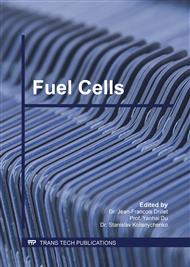p.461
p.467
p.471
p.477
p.483
p.489
p.494
p.500
p.507
Influence of Bi2O3 on Crystalline Phase Content and Thermal Properties of Åkermanite and Diopside Based Glass-Ceramic Sealant for SOFCs
Abstract:
Solid oxide fuel cell (SOFC) is an electrochemical energy conversion device which is considered as clean energy source generator with reliability and relatively inexpensive production cost. One of the most important components for planar design SOFC is the hermetic seal that prevents fuel from leaking out of between the stack of fuel cells. Glass-ceramics are attractive materials as sealing materials for this device. The expected coefficient of thermal expansion (CTE) of the glass-ceramic sealants should be between 9 and 12 x 10−6 K−1. Glass – ceramics based on åkermanite (Ca2MgSi2O7) crystalline phase were reported their high CTE value from about 10 to 11.3 x 10−6 K−1. In this study, glass compositions in the CaO-MgO-B2O3-Al2O3-SiO2 system with varying amounts of Bi2O3 from 0 to 10 wt. % were prepared by conventional melting and investigated their properties. The selected compositions were derived from ternary åkermanite–forsterite–anorthite phase diagram. Phase composition and quantitative phase analysis of glass–ceramics were examined by X-ray diffractometer. The onset of crystallization (Tx) and crystallization temperature (Tc) were measured by DTA. The thermal properties of bulk glass samples and heat treated samples at 900 oC for 2 h which were glass transition temperature (Tg), dilatometric softening temperature (Ts), and coefficient of thermal expansion (CTE) were determined by dilatometer. Furthermore, the long-term stability of their CTE was investigated. The samples were continued to soak at 800 °C for 100 h and observed their change in CTE value. The results found that the åkermanite phase tended to increase with increasing amount of Bi2O3 content.
Info:
Periodical:
Pages:
483-488
Citation:
Online since:
August 2017
Keywords:
Price:
Сopyright:
© 2017 Trans Tech Publications Ltd. All Rights Reserved
Share:
Citation:



